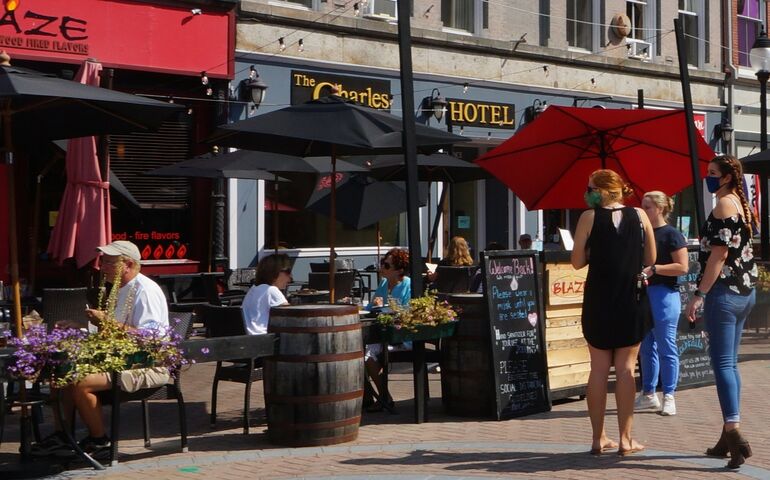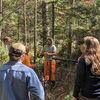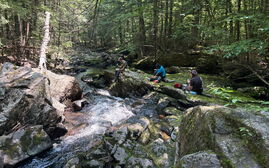Maine indoor gathering numbers increased; bars, tasting rooms can open Nov. 2
 Photo / Maureen Milliken
With winter coming and outdoor gathering, as with these restaurants on Broad Street in Bangor, getting less doable, the state has expanded indoor gathering rules for businesses, organizations and events.
Photo / Maureen Milliken
With winter coming and outdoor gathering, as with these restaurants on Broad Street in Bangor, getting less doable, the state has expanded indoor gathering rules for businesses, organizations and events.
Indoor gatherings can increase to half of capacity, with a maximum of 100 people next week, and bars and tasting rooms can open Nov. 2, after input from the state's chambers of commerce, Gov. Janet Mills announced Tuesday.
The move, Stage 4 of the state's reopening plan, increases indoor gatherings in places that have seating. The increase is for all indoor gatherings, including churches, movie theaters, meetings and other events. Those where activities are not done while seated — gyms, for instance — are still limited to 50 people.
Bars and tasting rooms, the last businesses restricted under the state's COVID-19 public health rules will finally be able to open under the same guidelines next month.
The outdoor gathering limit remains at 100 people. Retailers remain subject to the occupancy limit of 5 people per 1,000 square feet of shopping space.
Mills' administration worked with chambers of commerce, including Portland Regional, Lewiston-Auburn Metropolitan and Bangor Region to come up with the new rules. The chambers worked with their restaurant member teams to solicit feedback, and the primary ask was to be able to operate at 50% capacity, Mills said. Visit Portland and Visit Bangor Regional Convention and Visitor bureaus also weighed in.
Mills said the expanded indoor gathering number was also prompted by the fact that winter is coming and businesses won't be able to serve customers outdoors as they have most of the summer and early fall. The state also considered Maine's continuing low COVID-19 numbers. If those numbers change, stricter restrictions could be put in place, she said.
“With winter weather approaching, we must support businesses across the state as outdoor service becomes less viable and people move inside," Mills said. "This expanded capacity, along with continued health and safety precautions, is a prudent step forward that balances public health and economic health."
Business face covering rules get stricter
Mills also expanded the executive order requiring face coverings for staff and visitors to more entities, including private schools and municipal buildings, as well as making the order statewide. Previously, it covered restaurants, lodging establishments and retail businesses and was limited to coastal and more populous areas of the state.
She stressed that face coverings are a proven way to effectively slow the spread of the coronavirus.
The state's residents and businesses have been able to maintain the economic/health balance so far, "although it has been difficult and painful for many businesses," Mills said at Tuesday's Maine Centers for Disease Control and Prevention COVID-19 briefing. "As winter approaches, we need to maintain this delicate balancing act."
Jeanne Lambrew, commissioner of health and human services, said that the guidelines for the expanded opening are the same for any entity that qualifies by size and seating. "We don’t want differences or loopholes," she said.
She stressed that in bars, as well as churches, or any other indoor venue, there still can't be live singing and certain instrumental music, because singing has been found to project droplets that contain the virus farther and in greater profusion than talking. No dancing or dance floors are allowed, because they don't allow for social distancing.
The state published new COVID-19 Prevention Checklists for businesses and organizations, given the changes in what's allowed, on the Department of Economic and Community Development website. The checklists cover guidelines for enhanced cleaning, social distancing, and more.
Mills said that the state will listen to feedback to see if other adjustments may be made "that support business and public health."
That was reiterated by Heather Johnson, commissioner of the Department of Economic and Community Development. “We recognize that winter capacity is critical to Maine businesses and want to ensure that we find alternatives that support both businesses while protecting public health,” she said. "We will continue to review creative options for other sectors as we move in to Stage 4.”
Mills also warned that the expanded opening "should not lure us into any false sense of security, the virus is still very much with us," and said that wearing face coverings, maintaining six-foot distance, avoiding large gatherings and washing hands are still essential.
Enforcement, compliance action
Lambrew said that if there are "problems with compliance, we’ll take action." She said the state will review the guidelines with non-complying businesses and give them time to adjust.
"We have seen some areas of concern in the last couple weeks," she said at Tuesday's briefing.
The news release from Mills' office was more forceful. It said that businesses that violate the executive order are subject to enforcement, including possible fines and loss of licenses, Mills said.
To date, state officials have issued fines — in one instance nearly $20,000 — and more than two dozen imminent health hazard warnings to organizations that have not abided by the health and safety measures meant to protect their employees, customers and clients, according to the release.
Mills said, too, in response to a reporter's question at the briefing, that the expanded opening combined with stricter face covering rules is not a mixed message.
'It's a balancing act," she said. The added face covering rules and enforcement are what allows wider opening, because they ensure it can be done safely.
Nirav Shah, director of Maine CDC, said there are no specific numbers that will allow the expanded opening to continue or be restricted; it's more a matter of maintaining the gains the state has made so far. His department monitors the daily number of new cases, their geographic distribution, number of hospitalizations, the positivity rate aggregate as well as the number of days below a certain threshold and more to decide what's safe for public health, he said.
"If we see signs we’re regressing, which could be a sign of worse things to come," then the opening is reconsidered.
As of last Friday, Maine, adjusted for population, ranked second lowest in the nation for positive COVID-19 cases; fourth lowest for deaths; the lowest for patients hospitalized with COVID-19 since March, out of the 36 states reporting; and ninth highest in the percentage of people who have recovered out of the 45 states reporting.














0 Comments